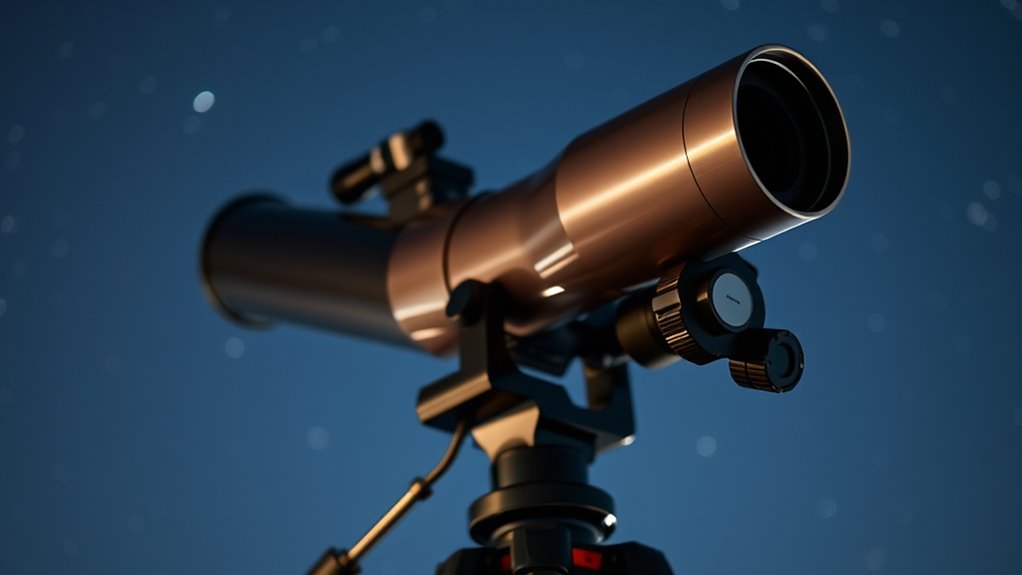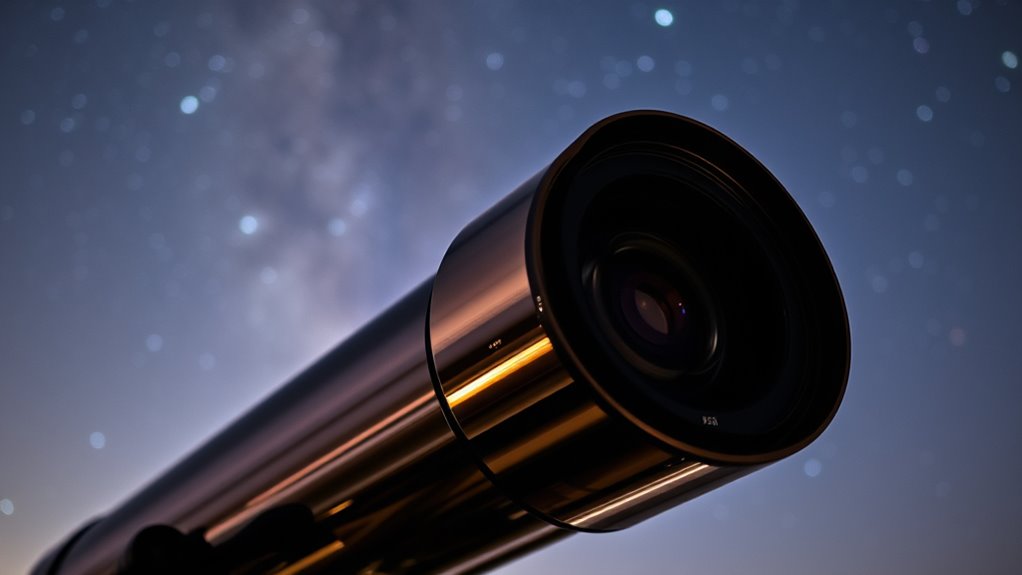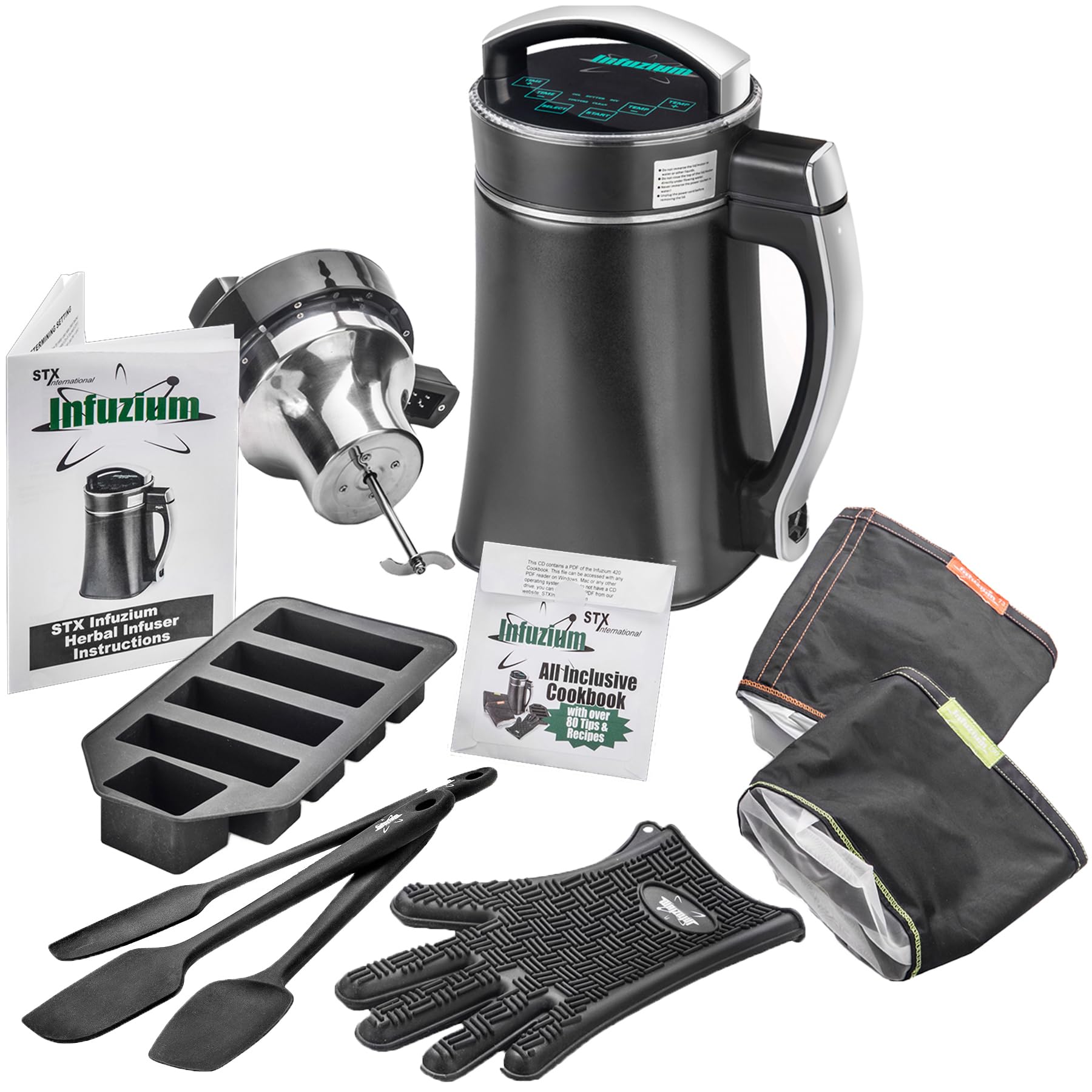If you’re looking for the best 130mm triplet APO refractors for astrophotography, I recommend considering models like the Explore Scientific FCD100 and SVBONY SV550, as they offer high optical quality, precise focusers, and good portability. These telescopes deliver excellent sharpness with minimal aberration, perfect for capturing planets and deep-sky objects. Stay with me to discover detailed reviews and expert tips that will help you choose the perfect instrument for your stargazing adventures.
Key Takeaways
- High-quality 130mm triplet APO refractors feature premium ED glass and multi-layer coatings for minimal chromatic aberration and sharp celestial images.
- A stable, dual-speed focuser (preferably 2.5-inch or larger) ensures precise focusing critical for astrophotography.
- Lightweight, portable designs with compatible mounts and balanced weight allow for easy outdoor setup and travel flexibility.
- Optical performance, build quality, and accessory compatibility vary; higher-priced models generally offer better stability and image clarity.
- Additional features like dew shields, field flatteners, and robust mounting options enhance imaging quality and overall value.
Explore Scientific FCD100 127mm f/7.5 Carbon Fiber Triplet ED APO Refractor Telescope
If you’re an advanced amateur astronomer seeking high-quality astrophotography capabilities, the Explore Scientific FCD100 127mm f/7.5 Carbon Fiber Triplet ED APO Refractor Telescope is worth considering. It features a 127mm aperture, f/7.5 focal ratio, and a 952mm focal length, delivering sharp images with a 0.9 arcsecond resolution and a limiting magnitude of 13. The lightweight design at 14 pounds and the sturdy 2.5 HEX focuser make it suitable for detailed observations and astrophotography. However, some users find the optics decent but not exceptional for the price, and the included components may require upgrades for ideal performance.
Best For: advanced amateur astronomers interested in astrophotography who are willing to upgrade components and accept limited customer support.
Pros:
- High-quality optical performance with a resolution of 0.9 arcseconds and limiting magnitude of 13.
- Lightweight and portable design weighing only 14 pounds, suitable for mobile observations.
- Sturdy 2.5 HEX focuser ideal for precise focusing during astrophotography.
Cons:
- Included focuser and diagonal components are subpar and may require upgrades for optimal use.
- Mixed user reviews regarding optical quality, with some finding the optics only decent for the price.
- Poor customer service and limited warranty support, with reports of unresponsive support and difficulty resolving issues.
Explore Scientific ED80 Triplet Refractor Telescope
The Explore Scientific ED80 Triplet Refractor Telescope stands out as an excellent choice for astrophotographers seeking high optical quality in a portable package. It features genuine FCD1 HOYA ED glass and multi-layer coatings, delivering sharp, high-contrast images with minimal chromatic aberration. Its 80mm aperture and f/6 focal ratio make it versatile for both visual observation and astrophotography. Weighing just under 6 pounds, it’s lightweight and compact, ideal for quick setups. Although some mounting adjustments are recommended, the scope’s build quality and optical performance make it a top pick for those wanting a portable, high-performance triplet refractor.
Best For: amateur astronomers and astrophotographers seeking a portable, high-quality triplet refractor for detailed celestial imaging and visual observation.
Pros:
- Exceptional optical quality with genuine FCD1 HOYA ED glass and multi-layer coatings for high contrast and minimal chromatic aberration.
- Lightweight and compact design, weighing under 6 pounds, ideal for quick setup and portability.
- Versatile use for both astrophotography and visual astronomy with sharp, detailed images of various celestial objects.
Cons:
- Mounting system may require modifications or additional accessories for optimal stability and compatibility.
- Proprietary finder scope mount can limit accessory options without adapters or custom solutions.
- Some users report minor manufacturing defects and mounting challenges that may need troubleshooting or upgrades.
Celestron Omni XLT 120 Refractor Telescope
Designed for amateur astronomers seeking sharp, high-contrast images, the Celestron Omni XLT 120 Refractor Telescope features premium optical glass and fully multi-coated lenses that maximize light transmission. Its 120mm aperture delivers crisp views of the Moon and planets, with minimal aberration. The included 25mm eyepiece provides wide, sharp visuals, while upgraded eyepieces enhance high-power planetary details. Mounted on a sturdy CG-4 German equatorial mount with smooth tracking, it offers reliable stability and precise control. Despite some logistical issues reported by users, its optical quality, portability, and software extras make it a solid choice for both casual and serious amateur astronomers.
Best For: amateur astronomers and stargazing enthusiasts seeking sharp, high-contrast images of the Moon, planets, and bright deep-sky objects with reliable stability and portability.
Pros:
- High-quality, fully multi-coated optical glass provides bright, crisp images with minimal aberration.
- Sturdy CG-4 German equatorial mount with smooth tracking and precise control enhances observing experience.
- Portable design with easy setup allows quick assembly and transport to various observation sites.
Cons:
- Shipping and packaging issues reported by some users can lead to incomplete or delayed deliveries.
- Finderscope’s upside-down image and lack of a diagonal may cause inconvenience during overhead viewing.
- Limited aperture (120mm) restricts deep-sky object visibility compared to larger telescopes.
SVBONY SV550 Triplet APO Telescope
For amateur astronomers seeking a portable yet high-performing astrophotography telescope, the SVBONY SV550 Triplet APO stands out with its 122mm aperture and high-quality FPL-51 triplet lens. Weighing just over 14 pounds, it’s easy to transport and comes with a protective carrying case. Its F7 focal ratio and 854mm focal length deliver sharp, detailed images of deep-sky objects and planets. The dual-speed 2.5-inch focuser ensures precise focusing, while the sturdy build supports heavy cameras and accessories. Overall, this scope offers excellent optical performance, minimal chromatic aberration, and great portability at a very attractive price point under $1,500.
Best For: amateur astronomers and astrophotographers seeking a portable, high-performance APO telescope for detailed deep-sky and planetary imaging.
Pros:
- Excellent optical quality with FPL-51 triplet lens providing minimal chromatic aberration and sharp images
- Lightweight and portable design with a durable carrying case, ideal for travel and outdoor use
- Robust dual-speed 2.5-inch focuser allows precise focusing for astrophotography and detailed viewing
Cons:
- Support services and parts availability can be limited or inconsistent
- Slightly sensitive to dust and dirt between lens elements if not handled carefully
- Compatibility with some accessories may require additional adapters or adjustments
Explore Scientific FCD100 Series 80mm Air-Spaced Apochromatic Triplet Refractor Telescope
If you’re seeking a portable yet high-performing astrophotography telescope, the Explore Scientific FCD100 Series 80mm Air-Spaced Apochromatic Triplet Refractor offers an exceptional choice. Its high-contrast optics, crafted from genuine Hoya FCD100 ED glass with multi-layer coatings, deliver sharp, detailed images free of chromatic aberration. The 80mm aperture and 480mm focal length provide excellent light-gathering capability while maintaining a lightweight, compact design. Features like a precise 2.5-inch focuser, dew shield, and versatile mounting options make it ideal for both visual observing and astrophotography. Plus, Explore Scientific’s reliable customer support and warranty guarantee peace of mind with your investment.
Best For: amateur astronomers and astrophotographers seeking a portable, high-quality apochromatic refractor for detailed celestial observation and imaging.
Pros:
- High-contrast, sharp images thanks to genuine Hoya FCD100 ED glass and multi-layer coatings
- Virtually eliminates chromatic aberration with air-spaced triplet design
- Lightweight and compact, making it highly portable and easy to set up
Cons:
- May have a higher price point compared to entry-level telescopes
- Requires careful handling and proper mounting for optimal performance
- Limited aperture size may restrict deep-sky object brightness for some users
SVBONY SV105 Telescope Camera, 1.25″ CMOS Astrophotography Camera
Looking to plunge into planetary astrophotography without breaking the bank? The SVBONY SV105 Telescope Camera is an excellent entry-level choice. It features a 1/2.8” CMOS sensor that captures 1920×1080 resolution at 30 fps, ideal for lunar and planetary imaging. Its 1.25-inch threaded interface fits most telescopes and supports filters, although some users report a tight fit. Compatible with Windows, Linux, Android, and macOS, it offers plug-and-play operation with no driver needed. While setup can be tricky at times, many beginners appreciate its affordability and decent image quality. Overall, the SV105 is a solid, budget-friendly option to start exploring planetary astrophotography.
Best For: Beginners and amateur astronomers seeking an affordable, easy-to-use camera for planetary and lunar astrophotography.
Pros:
- Plug-and-play operation with no driver installation required.
- Compatible with multiple operating systems including Windows, Linux, Android, and macOS.
- Compact, lightweight design making it portable and easy to handle.
Cons:
- Some users report a tight fit requiring modifications to attach to telescopes.
- Occasional recognition issues or overheating during extended use.
- Limited resolution and features compared to higher-end astrophotography cameras.
Celestron StarSense Explorer DX 130AZ Telescope with Smartphone Dock
The Celestron StarSense Explorer DX 130AZ Telescope with Smartphone Dock stands out as an excellent choice for beginners enthusiastic to explore the night sky without the complexity of traditional astronomy setups. Its 130mm Newtonian reflector provides sharp, bright views of the Moon, planets, and deep-sky objects like the Orion Nebula and Andromeda Galaxy. The innovative StarSense technology uses sky recognition to help you locate objects effortlessly via your smartphone. With a user-friendly altazimuth mount and simple setup, it’s perfect for new stargazers. Plus, the included app guides you step-by-step, making celestial navigation accessible and enjoyable for everyone.
Best For: beginner astronomy enthusiasts seeking an easy-to-use, smartphone-integrated telescope for exploring the night sky.
Pros:
- User-friendly setup with simple smartphone docking and SkySense app guidance
- Sharp, bright views of planets, the Moon, and deep-sky objects thanks to 130mm aperture
- Portable and lightweight design suitable for both city and dark-sky observations
Cons:
- Manual altazimuth mount may not be ideal for advanced tracking or astrophotography
- Limited to visual observation; not designed for astrophotography or long-exposure imaging
- Smartphone dependency means quality may vary based on device and app updates
Explore Scientific FCD100 Series ED102 Refractor Telescope
The Explore Scientific FCD100 Series ED102 Refractor Telescope stands out as an excellent choice for serious astrophotographers seeking sharp, color-accurate images. Its 102mm aperture and f/7 optical design deliver crisp, high-contrast views with minimal chromatic aberration, thanks to genuine HOYA FCD100 ED glass. The proprietary EMD multi-layer coatings enhance image clarity and contrast, making it ideal for detailed astrophotography. Weighing just 10.9 pounds and measuring 28 inches long, it’s portable without sacrificing performance. Whether you’re capturing planets or deep-sky objects, this refractor offers excellent optical quality in a lightweight package, making it a top contender for advanced astrophotographers.
Best For: Serious astrophotographers seeking high-precision, color-accurate images with minimal chromatic aberration in a portable, lightweight refractor telescope.
Pros:
- Exceptional optical quality with genuine HOYA FCD100 ED glass for advanced chromatic aberration correction
- Lightweight design at just 10.9 pounds, making it highly portable and easy to handle
- Proprietary EMD multi-layer coatings enhance image clarity, contrast, and overall viewing experience
Cons:
- Limited to OTA (telescope tube) only; requires additional mounts and accessories for complete setup
- Price may be higher compared to entry-level refractors, reflecting its advanced optical features
- Currently only rated by a single customer review; broader user feedback may provide more insights
Explore Scientific ED102 Refractor Telescope for Astrophotography
If you’re seeking a portable yet highly capable refractor for astrophotography, the Explore Scientific ED102 stands out as an excellent choice. Its 102mm aperture and 714mm focal length deliver sharp, high-contrast images with minimal chromatic aberration, thanks to genuine FCD1 ED glass and multi-layer coatings. The air-spaced triplet design ensures crisp stars across the field, suitable for capturing planets, nebulae, and deep-sky objects. Weighing around 12 pounds with a compact build, it’s easy to set up and transport. Its user-friendly features, like a retractable dew shield and compatible accessories, make it perfect for both field astrophotography and visual observation.
Best For: amateur astronomers and astrophotographers seeking a portable, high-quality refractor for capturing detailed lunar, planetary, and deep-sky images, even in light-polluted environments.
Pros:
- Exceptional optical quality with genuine FCD1 ED glass and multi-layer coatings for sharp, color-accurate images
- Lightweight and portable design, weighing around 12 pounds, easy to transport and set up in minutes
- Suitable for both visual observation and astrophotography, compatible with various accessories and mounts
Cons:
- Slight slop in the focuser at fine focus, which may require minor adjustments or upgrades
- Minor optical imperfections such as edge shaping of the airy disc and collimation nuances
- Some accessories, like finder scopes and extension tubes, are required separately for optimal use
SVBONY SV550 Telescope with 80mm F6 APO Triplet Refractor and Accessories
Designed for astrophotographers seeking high-quality yet affordable gear, the SVBONY SV550 Telescope with its 80mm F6 APO triplet refractor offers impressive optical performance in a compact package. Its advanced internal light barriers guarantee excellent light suppression, while the magnesium alloy focusing seat reduces weight and boosts durability. The 180mm dovetail plate provides stability and easy accessory mounting. Included field flattener with M63 extension tube and M48 adapter ensures a 55mm back focus, ideal for full-frame cameras. With sharp, color-accurate images and minimal aberrations, it’s a versatile, portable choice for deep sky astrophotography, perfect for both beginners and enthusiasts.
Best For: amateur astrophotographers and beginners seeking a high-quality, portable APO triplet refractor for deep sky imaging at an affordable price.
Pros:
- Excellent optical performance with sharp, color-accurate images from edge to edge
- Compact and lightweight design enhances portability and ease of setup
- Advanced internal light barriers effectively suppress stray light for clear imaging
Cons:
- Focus locks are simple push knobs that may lack fine adjustment precision
- Potential contact issue with low-profile mount rails when balancing the scope
- Internal dust can be present but is easily cleaned, requiring minimal maintenance
Askar 120APO Telescope for Astrophotography and Viewing
For astrophotographers seeking a high-quality, portable refractor, the Askar 120APO stands out with its 120mm aperture and F7 focal ratio, offering sharp images and excellent color correction. Its triplet air-spaced APO design, including ED glass, guarantees minimal chromatic aberration and high clarity. Weighing just 5.7kg, it’s easy to transport and set up for both astrophotography and visual observing. The package includes a sturdy handle, tube rings, a Vixen dovetail, and a carrying case, making it a versatile and convenient choice. With an 840mm focal length, it delivers detailed images across a range of celestial targets.
Best For: amateur astrophotographers and visual observers seeking a portable, high-quality refractor telescope with excellent color correction and sharp images.
Pros:
- High-quality triplet air-spaced APO design with ED glass for minimal chromatic aberration
- Lightweight and portable at just 5.7kg, easy to transport and set up
- Includes comprehensive accessories like tube rings, handle, Vixen dovetail, and carrying case for convenience
Cons:
- Focal length of 840mm may limit wide-field imaging compared to longer focal length scopes
- Price may be higher for entry-level users seeking more basic telescopes
- Limited to visual and astrophotography use; not suitable for very deep-sky objects requiring larger apertures
Factors to Consider When Choosing 130MM Triplet APO Refractors for Astrophotography

When selecting a 130mm triplet APO refractor for astrophotography, I focus on key factors like optical quality, focuser stability, and mount compatibility to make certain of sharp images and smooth operation. I also consider portability and travel ease, since transporting equipment can be a challenge, along with balancing price and value. Understanding these points helps me choose a model that fits both my imaging needs and budget.
Optical Quality and Glass
Optical quality and the choice of glass are crucial factors that determine the performance of a 130mm triplet APO refractor in astrophotography. High-quality scopes use ED or FCD100 glass to virtually eliminate chromatic aberration, delivering sharper images with minimal color fringing. Genuine optical glass like Hoya FCD100 or FPL-51 is essential for achieving high contrast and accurate color correction. Multi-layer coatings on all optical surfaces boost light transmission, enhance contrast, and reduce reflections, resulting in clearer images. The air-spaced triplet design allows for precise correction of optical aberrations, producing crisp stars from edge to edge. Ultimately, the glass type and coatings directly influence a scope’s ability to capture detailed planetary, lunar, and deep-sky images with minimal false color.
Focuser Precision and Stability
A precise and stable focuser is essential for capturing sharp astrophotos with a 130mm triplet APO refractor. A high-quality focuser, ideally dual-speed with a 2.5-inch or larger diameter and a gear ratio of 1:10 or better, allows for fine, accurate focus adjustments. It should have minimal optical slop and backlash to prevent focus shifts during imaging sessions. Robust construction, often made from metal or high-strength materials, ensures stability and prevents flexure under heavy camera or accessory loads. Smooth, backlash-free focusing mechanisms are critical for achieving pinpoint focus at high magnifications. Additionally, a reliable locking mechanism keeps the focus position secure, maintaining consistent focus during long exposures. Overall, focuser quality directly impacts image sharpness and ease of use.
Mount Compatibility and Weight
Ensuring your 130mm triplet APO refractor is compatible with your mount is essential for stable astrophotography sessions. Check that the telescope’s dovetail or mounting foot matches your mount’s saddle for secure attachment. Consider the total weight, including accessories like cameras and guidescopes, to avoid overloading your mount’s maximum payload capacity. It’s also important to verify that the mount can handle the telescope’s weight—some models are around 14 pounds—and that weight distribution is balanced, especially with heavier add-ons. Ease of mounting and dismounting matters if you frequently set up or transport your equipment, so choose a setup that offers convenience. Proper compatibility ensures stability, minimizes vibrations, and supports long, accurate exposures.
Portability and Travel Ease
When selecting a 130mm triplet APO refractor for astrophotography, portability and ease of travel should be top priorities. Many models weigh between 10 to 15 pounds, making them manageable to carry and transport. Compact designs, with features like retractable dew shields and shorter focal lengths, further reduce bulk, easing packing and setup. Using lightweight dovetail plates and sturdy, portable tripods simplifies field assembly and stability. Smaller form factors mean these telescopes can often fit into carry-on luggage or backpacks, streamlining airline travel and outdoor excursions. Additionally, models with built-in handles or dedicated carrying cases help protect the scope and make handling during transit much easier. Prioritizing portability ensures you can enjoy astrophotography adventures with less hassle.
Price and Value Balance
Balancing price and value is essential when choosing a 130mm triplet APO refractor for astrophotography, as higher costs don’t always guarantee better performance. While more expensive models often feature superior optical quality and build, this isn’t always the case, so it’s important to weigh what you’re getting against the price. Budget-friendly options might lack advanced coatings or precise collimation, which can affect image quality. Sometimes, investing a bit more yields better focuser stability and accessories, boosting overall value. Comparing optical performance—like chromatic aberration correction and resolution—relative to cost helps ensure you’re making a smart choice. Considering long-term upgradeability and support can also add value, even if the initial price is higher. It’s all about finding the right balance for your needs and budget.
Frequently Asked Questions
What Are the Maintenance Requirements for 130MM Triplet APO Refractors?
Maintaining my 130mm triplet APO refractor is pretty straightforward. I regularly clean the lens with a soft brush and gentle lens cleaner to prevent dust buildup. I also keep it covered when not in use to protect against dust and moisture. Periodically, I check the collimation and tighten any loose screws. Storing it in a dry, cool place helps preserve its optical quality over time.
How Do Temperature Changes Affect Image Quality in These Telescopes?
Temperature changes can considerably impact image quality in 130mm triplet APO refractors. When it’s cold or hot, the telescope’s materials expand or contract, causing slight misalignments or focus shifts. I make sure to give my scope time to acclimate to the ambient temperature before observing, and I use fan systems or dew heaters to stabilize temperature differences. This helps me achieve sharper, clearer images during my astrophotography sessions.
Are There Specific Mount Types Recommended for Optimal Performance?
For ideal performance, I recommend a sturdy equatorial mount, like a German equatorial or a high-quality altazimuth mount with tracking capabilities. These mounts provide smooth, precise movement essential for astrophotography. I’ve found that a mount with good weight capacity and motorized tracking helps me capture sharp images, especially during long exposures. Ensuring your mount is well-balanced and stable makes a big difference in achieving clear, detailed astrophotos.
What Accessories Enhance Astrophotography With 130MM Triplet APOS?
This accessory list will blow your mind—it’s essential for stellar astrophotography! I swear by a high-quality equatorial mount with precise tracking; it keeps my images razor-sharp. A good field flattener or reducer is a game-changer, ensuring stars stay round across the frame. Don’t forget a reliable auto-guiding system to minimize errors during long exposures. Finally, a sturdy, adjustable tripod makes all the difference for stable, clear shots.
How Does Chromatic Aberration Vary Among Different Models?
Chromatic aberration varies quite a bit among different models, and I’ve noticed that premium triplets tend to have better control over it. Some models, especially those with ED or FPL-53 glass, show minimal color fringing, even on bright objects. Cheaper options might exhibit more noticeable chromatic aberration, which can be a headache for astrophotography. So, I always recommend investing in a high-quality triplet for clearer, sharper images.
Conclusion
After exploring these top 130mm triplet APO refractors, I realize how chance often leads us to the perfect match—whether it’s the right aperture, price, or brand. Sometimes, I stumble upon a telescope that just feels right, almost like a coincidence. Whatever your choice, trust that finding the right scope can turn unexpected moments into unforgettable astrophotography experiences. Happy stargazing—sometimes, the universe has a way of guiding us exactly where we need to be.






















